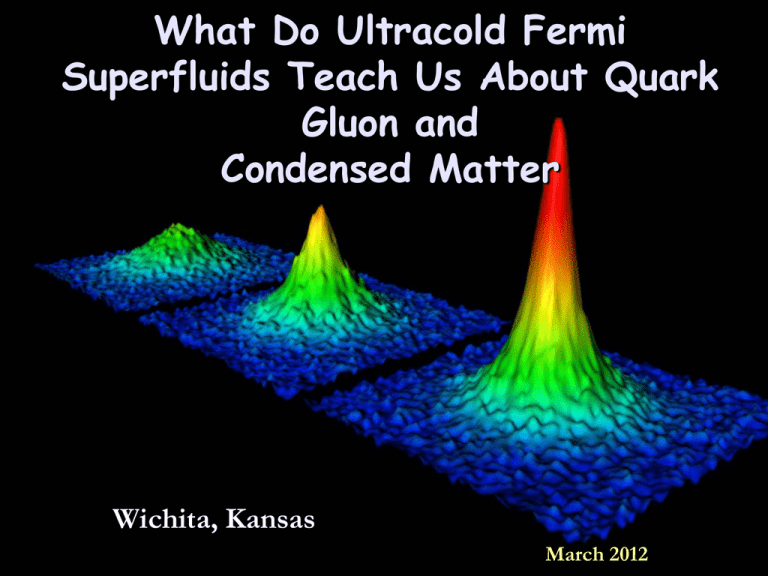WSUphys2012mar7LevinSeminar
advertisement

What Do Ultracold Fermi Superfluids Teach Us About Quark Gluon and Condensed Matter Wichita, Kansas March 2012 Combine Quark Gluon Physics and Atomic Fermi Gases (+ High Tc) Superconductivity Collaborators Qijin Chen (Zhejiang Univ) ChihChun Chien, Yan He, Hao Guo, Dan Wulin Also John Thomas, Debbie Jin groups Outline of Talk Summary of what cold Fermi gases may have in common with quark gluon plasmas (and high Tc Superconductors). Summary of Ground-breaking experiments in cold gases. A refresher course on superconductivity. Controversy about “perfect fluidity” – anomalously low viscosity. Superfluidity Associated with at Least Nine Nobel Prizes 1913 Onnes for superconductivity-expt 1972 Bardeen, Cooper, Schrieffer (BCS)theory 1987 Bednorz and Muller– high Tc- expt 2001 BEC in trapped Bose gases-expt 2003 Abrikosov, Leggett, Ginzburg- theory 2008 Nambu– BCS theory in particle physics. …….. And still counting ! Impact on Other Subfields of Fermionic Superfluidity Pairing in Nuclear Physics– Bohr, Mottelson, Pines. Dense Quark matter, color superconductivity in RHIC Hadronic superfluidity in neutron stars. Applications to accelerator magnets,MRI… The Essence of Fermionic Superfluidity Increased attraction fermions bosons Attractive interactions turn fermions into “composite bosons” (or Cooper pairs). These are then driven by statistics to Bose condense. . Remarkable Tuning Capability in Cold Gases via Feshbach Resonance Feshbach Resonance BEC R Tuneable attraction: with varying magnetic field. BCS Magnetic-field Feshbach resonance Magnetic Field BEC– strong attraction Unitary limit Summary of Trapped Fermi Gases Mainly 40K and 6Li. Highly dilute: Number of atoms N=105-106. Fermi temperature EF ~ 1 mK. Cooled down to T~10-100 nK Expts. explore crossover near unitarity Interdisciplinary aspects of BCS-BEC Crossover AMO Perspective– Can explore new states of matter. Crossover completely accessible via magnetic fields. Condensed Matter perspective – Opportunity to explore bigger-than-BCS theory. Crossover may be relevant to cuprate superconductors. Nuclear/Particle/Astrophysics –Unitary scattering regime is prototype for strongly interacting Fermi systems: neutron stars, quark-gluon plasmas, nuclear matter. String theory and AdS/CFT Conjecture: Minimum shear viscosity . Dense Quark Matter and Ultracold Fermi Gases Energy Scales 0f Cold Gases and Quark-Gluon Plasma Separated by ~21 decades: See Physics today, May 2010 page 29 Deconfined quark-gluon plasmas made in ultrarelativistic heavy ion collisions T ~ 102 MeV ~ 1012 K (temperature of early universe at 1m sec) Trapped cold atomic systems: Bose-condensed and BCS fermion superfluid states T ~ nanokelvin (traps are the coldest places in the universe!) Dense Quark Matter and Ultracold Fermi Gases Phase Diagram for Fermi atomic superfluids temperature . Phase Diagram in quark-gluon plasma Gordon Baym, T. Hatsuda Quark-gluon plasma tricritical point Hadronic matter: Neutrons, protons, pions, … BEC (?) Chiral symmetry breaking Pseudogap? chirally symmetric (Bose-Einstein decondensation) BCS paired quark matter (color superconductivity) (density) . Experiments in Ultracold Fermi Gases Complexity of Cold Gases How can we prove superfluidity ? How can we measure temperature? How can we measure the pairing gap How can we measure transport? Example: Experimental Apparatus of Duke Group ? First Generation Experiments: Indirect Evidence for Superfluidity of Unitary gases: magnetic field sweeps to BEC Jin et al, PRL 92, 040403 (2004) Thomas et al,Science 307, 1296 (2005) Observation of quantized Vortices at MIT Zwierlein et al , Nature 435, 170404 (2005) Second Generation Experiments: Radio Frequency Probes which measure pairing RF Note close analogy with photoemission Paired atoms are excited to higher hyperfine level. The trap is turned off and momentum distribution is measured after time of flight. Energy vs momentum of initial (paired) states is then inferred. Third Generation: Transport Experiments See Physics today, May 2010 page 29 String theory and experiment suggest that in the quantum world the viscosity can only be so low. Via AdS/CFT: 1 s 4 kB At the same time there is controversy about how the shear viscosity behaves at the lowest temperatures. Will be discussed in this talk. . Remarkable Similarity of Experimental Probes: Atomic Physics and Condensed matter . Theory Interlude Number Equation Zero chemical Potential Noncondensed bosons Number of condensed bosons …………………………………. Statistical Basis of Ideal Bose Condensation (BEC) then determined. Comparing T=0 BCS and Fermi Gas Fermi Gas BCS superconductor excitation gap for fermions No excitation gap BCS-BEC Crossover– Tuneable attractive interaction BEC– strong attraction Contrast Between BCS and BCS-BEC Crossover . In BCS theory all energy scales are equal ! Due to stronger- than- BCS attraction pairs form at T* and condense at Tc. The pseudogap (pg) reflects preformed pairs above Tc. BCS-BEC Crossover Theory Pair chemical potential: Leads to BCS gap equation for Total ``number” of pairs Noncondensed pairs: …………………………………. Composite bosons Ideal Point bosons Excitations in BCS-BEC Crossover . Understanding the excitations is fundamental to understanding the physics: The excitations consist of non-condensed pairs and fermions. . Understanding “Perfect Fluidity”– low viscosity– associated with understanding the excitations. Recall the condensate has zero viscosity Different Predictions for Shear viscosity in cold gases Our prediction: We anticipate viscosity should not turn up at low temperatures. Excitations are gapped out. Quark Gluon Plasma (QCD) Predictions for viscosity– predict upturn at low T Difference Between Bosonic and Fermionic Superfluids The two predictions seem to follow the difference between helium-3 and helium-4 Helium 3 Helium 4 Helium 4 shows upturn Helium 3 shows no upturn The Difference gets to the heart of the physics– the nature of lowest T excitations. Which One is Right? To settle the issue turn to experiments which measure shear viscosity via damping of breathing mode. And the Answer is….. Experiments Measure Very Low Viscosity at the lowest temperatures as we predict. Viscosity /entropy viscosity Tc John Thomas– Science 2011 Wide Impact of Cold Gases RHIC physics . Perfect Fluids Fermi Gases Spectroscopy Transport Scattering Bad Metals Hi Tc cuprates Conclusions BCS-BEC crossover theory presents opportunity to generalize the paradigm of condensed matter theories = BCS theory. Can be studied in ultracold Fermi gases. Also may be relevant to the high temperature superconductors and quark-gluon plasmas. Can address paradoxes in both cuprates and dense quark matter using Fermi gases. Outline of Talk Summary of what cold Fermi gases may have in common with high temperature superconductors and quark gluon plasmas. Summary of Ground-breaking experiments in cold gases. Theory interlude. Similarity of Spectroscopic, Transport and Scattering probes. Controversies in cold gases and QGP viscosity predictions. Review Papers 1. Physics Reports 412, 1 (2005)Relation between cuprates and cold gases. 2. Reports in Prog. In Physics 72, 122501(2009). Relation between RF and photoemission. Shear viscosity : v F = A v /d Photoemission Analogue: Momentum Resolved RF in K-40 Jin et al (2010) . Below Tc Around Tc Above Tc Measure Viscosity by Breathing mode frequency and damping Theory and experiment Duke Experiment Low viscosity due to pseudogap and to bosonic degrees of freedom = perfect fluids. Analogue in cuprates = bad metals. Text Here Cooper pairs overlap Molecules form from unpaired atoms – random pairing What really happened during the projection? Revisiting Outline of Talk Summary of what cold Fermi gases may have in common with high temperature superconductors and quark gluon plasmas. Summary of Ground-breaking experiments in cold gases. Theory interlude. Similarity of Spectroscopic, Transport and Scattering probes. Controversies in cold gases, high Tc cuprates, and QGP viscosity predictions. Comparing Our Viscosity Predictions and Experiment Homogeneous theory Tc Theory and experiment in traps: Low viscosity due to pseudogap and to bosonic degrees of freedom = perfect fluids. Analogue in cuprates = bad metals. . The Cuprates and Ultracold Fermi Gases Why BCS-BEC Crossover may apply to High Tc Cuprates Pairs are anomalously small. BEC BCS Tc is high. “Glue” is strong Quasi 2 dimensional. “Pseudogap” (normal state gap) very prominent. cuprates Similarity of Phase diagrams . Cuprates BCS-BEC on d-wave paired lattice Tc vanishes in the fermionic regime– pair localization A Supporting Quote A. Leggett: “The small size of the cuprate pairs puts us in the intermediate regime of the so-called BCS-BEC crossover.” ( Summary article --Nature Phys. 2006). 1. Photoemission and RF Spectroscopy These detect the presence of pairing, based on fits to 2. Conductivity and Shear Viscosity These distinguish condensed and non-condensed pairs. v 3. Neutron scattering and 2-photon Bragg Unlike neutrons, Bragg measures spin and charge scattering SEPARATELY








